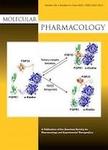版权所有:内蒙古大学图书馆 技术提供:维普资讯• 智图
内蒙古自治区呼和浩特市赛罕区大学西街235号 邮编: 010021

作者机构:Univ Colorado Inst Behav Genet Boulder CO 80303 USA Univ Utah Dept Biol Salt Lake City UT 84112 USA Univ Utah Dept Psychiat Salt Lake City UT 84112 USA
出 版 物:《MOLECULAR PHARMACOLOGY》 (分子药理学)
年 卷 期:2000年第57卷第5期
页 面:913-925页
核心收录:
学科分类:1007[医学-药学(可授医学、理学学位)] 10[医学]
基 金:NIDA NIH HHS [DA12242 R01 DA012242 DA03194 DA10156] Funding Source: Medline
主 题:放射自显影术 脑/药物作用 脑/代谢 细胞膜/药物作用 细胞膜/代谢 竞争性投标 芋螺毒素类/药理学 基因表达 原位杂交 碘放射性同位素 小鼠 近交C57BL 烟碱激动剂/药理学 烟碱拮抗剂/药理学 吡啶类/药理学 受体 胆碱能/代谢 氚 动物 男(雄)性 小鼠
摘 要:alpha-Conotoxin MII (CtxMII), a peptide toxin from the venom of the predatory cone snail Conus magus, displays an unusual nicotinic pharmacology. Specific binding of a radioiodinated derivative (I-125-alpha-CtxMII) was identified in brain region homogenates and tissue sections. Quantitative autoradiography indicated that I-125-alpha-CtxMII binding sites have an unique pharmacological profile and distribution in mouse brain, being largely confined to the superficial layers of the superior colliculus, nigrostriatal pathway, optic tract, olivary pretectal, and mediolateral and dorsolateral geniculate nuclei. Expression of alpha-CtxMII binding sites in the nigrostriatal pathway, combined with evidence for alpha-CtxMII-sensitivity of nicotine-induced [H-3]dopamine release in rodent striatal preparations indicates that I-125-alpha-CtxMII binding nicotinic acetylcholine receptors are likely to be physiologically important. Unlabeled alpha-CtxMII potently (K-i 10 mu M) interacted with I-125-alpha-bungarotoxin and (-)-[H-3]nicotine binding sites, confirming this compound s novel nicotinic pharmacology. Quantitative autoradiography revealed that alpha-CtxMII binds with high affinity at a subset of [H-3]epibatidine binding sites with relatively low cytisine affinity (cytisine-resistant sites), resolving [H-3]epibatidine binding into three different populations, each probably corresponding to a receptor subtype. The majority population seems to correspond to that which binds nicotine and cytisine with high affinity (cytisine-sensitive sites). Comparison of the cytisine-resistant population s distribution with that of alpha 3 subunit mRNA expression suggests that the fractions both more and less sensitive to alpha-CtxMII probably contain the alpha 3 subunit, perhaps in combination with different beta subunits.